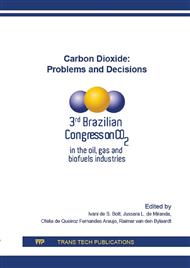p.71
p.78
p.85
p.95
p.109
p.117
p.125
p.134
p.139
Thermodynamic Studies of Iron Carbonate Solubility in Aqueous Monoethylene Glycol Mixtures and CO2 Atmosphere
Abstract:
Monoethylene glycol (MEG) is being widely applied as thermodynamic inhibitor to avoid formation of natural gas hydrates. High hydrophilicity, low toxicity, low viscosity, low solubility in liquid hydrocarbons and high capacity of dissolving salts are advantageous for the use of MEG in the natural gas production. In addition, MEG recovery can be easily achieved considering its low volatility in relation to water, which makes the process economical and environmentally feasible. The reuse of MEG is being theme of research and phase equilibrium data for the involved species are required. In this work, a experimental procedure to synthetize iron carbonate and, afterwards, determine its solubility in aqueous mixtures of MEG in the presence of carbon dioxide atmosphere have been developed. Furthermore, a series of solubility data has been measured. This work presents a worthy contribution to the description of iron carbonate aqueous solubilities in the presence of MEG and carbon dioxide, regarding the instability of the salt to respect of oxidation. Subsequently, the knowledge of the behavior of the iron carbonate solubilities is useful for the industrial unities of production of natural gas and recovery of MEG.
Info:
Periodical:
Pages:
134-138
Citation:
Online since:
March 2016
Keywords:
Price:
Сopyright:
© 2016 Trans Tech Publications Ltd. All Rights Reserved
Share:
Citation:


